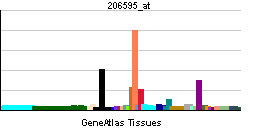CST6 (gene)
| Cystatin E/M | |||||||||||
|---|---|---|---|---|---|---|---|---|---|---|---|
| Identifiers | |||||||||||
| Symbols | CST6 ; | ||||||||||
| External IDs | Template:OMIM5 Template:MGI HomoloGene: 1011 | ||||||||||
| |||||||||||
| RNA expression pattern | |||||||||||
 | |||||||||||
| More reference expression data | |||||||||||
| Orthologs | |||||||||||
| Template:GNF Ortholog box | |||||||||||
| Species | Human | Mouse | |||||||||
| Entrez | n/a | n/a | |||||||||
| Ensembl | n/a | n/a | |||||||||
| UniProt | n/a | n/a | |||||||||
| RefSeq (mRNA) | n/a | n/a | |||||||||
| RefSeq (protein) | n/a | n/a | |||||||||
| Location (UCSC) | n/a | n/a | |||||||||
| PubMed search | n/a | n/a | |||||||||
Cystatin E/M, also known as CST6, is a human gene.[1]
The cystatin superfamily encompasses proteins that contain multiple cystatin-like sequences. Some of the members are active cysteine protease inhibitors, while others have lost or perhaps never acquired this inhibitory activity. There are three inhibitory families in the superfamily, including the type 1 cystatins (stefins), type 2 cystatins and the kininogens. The type 2 cystatin proteins are a class of cysteine proteinase inhibitors found in a variety of human fluids and secretions, where they appear to provide protective functions. This gene encodes a cystatin from the type 2 family, which is down-regulated in metastatic breast tumor cells as compared to primary tumor cells. Loss of expression is likely associated with the progression of a primary tumor to a metastatic phenotype.[1]
References
Further reading
- Brown WM, Dziegielewska KM (1997). "Friends and relations of the cystatin superfamily--new members and their evolution". Protein Sci. 6 (1): 5–12. PMID 9007972.
- Barka T, Asbell PA, van der Noen H, Prasad A (1991). "Cystatins in human tear fluid". Curr. Eye Res. 10 (1): 25–34. PMID 2029847.
- Saitoh E, Isemura S, Sanada K; et al. (1989). "Cystatin superfamily. Evidence that family II cystatin genes are evolutionarily related to family III cystatin genes". Biol. Chem. Hoppe-Seyler. 369 Suppl: 191–7. PMID 3202964.
- Thiesse M, Millar SJ, Dickinson DP (1994). "The human type 2 cystatin gene family consists of eight to nine members, with at least seven genes clustered at a single locus on human chromosome 20". DNA Cell Biol. 13 (2): 97–116. PMID 8179826.
- Sotiropoulou G, Anisowicz A, Sager R (1997). "Identification, cloning, and characterization of cystatin M, a novel cysteine proteinase inhibitor, down-regulated in breast cancer". J. Biol. Chem. 272 (2): 903–10. PMID 8995380.
- Ni J, Abrahamson M, Zhang M; et al. (1997). "Cystatin E is a novel human cysteine proteinase inhibitor with structural resemblance to family 2 cystatins". J. Biol. Chem. 272 (16): 10853–8. PMID 9099741.
- Stenman G, Aström AK, Röijer E; et al. (1997). "Assignment of a novel cysteine proteinase inhibitor (CST6) to 11q13 by fluorescence in situ hybridization". Cytogenet. Cell Genet. 76 (1–2): 45–6. PMID 9154125.
- Zeeuwen PL, Van Vlijmen-Willems IM, Jansen BJ; et al. (2001). "Cystatin M/E expression is restricted to differentiated epidermal keratinocytes and sweat glands: a new skin-specific proteinase inhibitor that is a target for cross-linking by transglutaminase". J. Invest. Dermatol. 116 (5): 693–701. doi:10.1046/j.1523-1747.2001.01309.x. PMID 11348457.
- Strausberg RL, Feingold EA, Grouse LH; et al. (2003). "Generation and initial analysis of more than 15,000 full-length human and mouse cDNA sequences". Proc. Natl. Acad. Sci. U.S.A. 99 (26): 16899–903. doi:10.1073/pnas.242603899. PMID 12477932.
- Zeeuwen PL, Dale BA, de Jongh GJ; et al. (2003). "The human cystatin M/E gene (CST6): exclusion candidate gene for harlequin ichthyosis". J. Invest. Dermatol. 121 (1): 65–8. doi:10.1046/j.1523-1747.2003.12312.x. PMID 12839564.
- Shridhar R, Zhang J, Song J; et al. (2004). "Cystatin M suppresses the malignant phenotype of human MDA-MB-435S cells". Oncogene. 23 (12): 2206–15. doi:10.1038/sj.onc.1207340. PMID 14676833.
- Zhang J, Shridhar R, Dai Q; et al. (2004). "Cystatin m: a novel candidate tumor suppressor gene for breast cancer". Cancer Res. 64 (19): 6957–64. doi:10.1158/0008-5472.CAN-04-0819. PMID 15466187.
- Gerhard DS, Wagner L, Feingold EA; et al. (2004). "The status, quality, and expansion of the NIH full-length cDNA project: the Mammalian Gene Collection (MGC)". Genome Res. 14 (10B): 2121–7. doi:10.1101/gr.2596504. PMID 15489334.
- Song J, Jie C, Polk P; et al. (2006). "The candidate tumor suppressor CST6 alters the gene expression profile of human breast carcinoma cells: down-regulation of the potent mitogenic, motogenic, and angiogenic factor autotaxin". Biochem. Biophys. Res. Commun. 340 (1): 175–82. doi:10.1016/j.bbrc.2005.11.171. PMID 16356477.
- Cheng T, Hitomi K, van Vlijmen-Willems IM; et al. (2006). "Cystatin M/E is a high affinity inhibitor of cathepsin V and cathepsin L by a reactive site that is distinct from the legumain-binding site. A novel clue for the role of cystatin M/E in epidermal cornification". J. Biol. Chem. 281 (23): 15893–9. doi:10.1074/jbc.M600694200. PMID 16565075.
- Ai L, Kim WJ, Kim TY; et al. (2007). "Epigenetic silencing of the tumor suppressor cystatin M occurs during breast cancer progression". Cancer Res. 66 (16): 7899–909. doi:10.1158/0008-5472.CAN-06-0576. PMID 16912163.
- Rivenbark AG, Jones WD, Coleman WB (2007). "DNA methylation-dependent silencing of CST6 in human breast cancer cell lines". Lab. Invest. 86 (12): 1233–42. doi:10.1038/labinvest.3700485. PMID 17043665.
- Schagdarsurengin U, Pfeifer GP, Dammann R (2007). "Frequent epigenetic inactivation of cystatin M in breast carcinoma". Oncogene. 26 (21): 3089–94. doi:10.1038/sj.onc.1210107. PMID 17099723.
- Rivenbark AG, Livasy CA, Boyd CE; et al. (2007). "Methylation-dependent silencing of CST6 in primary human breast tumors and metastatic lesions". Exp. Mol. Pathol. 83 (2): 188–97. doi:10.1016/j.yexmp.2007.03.008. PMID 17540367.
| This protein-related article is a stub. You can help Wikipedia by expanding it. |